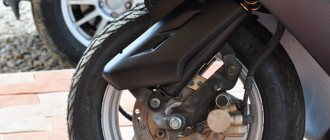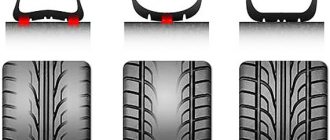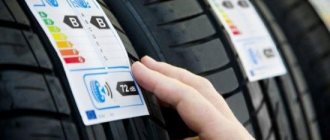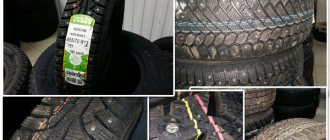How long can you use rubber?
Tires typically have a service life of 10 years from the date of manufacture. This is the period during which the tire retains its quality and is able to provide a safe ride, provided there is no damage and the permissible tread depth is maintained.
According to statistics, when used on city roads with uneven surfaces, the tire service life is about 5 years, and when used off-road or at high speeds with a sharp start - no more than 3 years. If you bought used tires, then you need to take into account possible storage in a cold garage or restoration, invisible to the naked eye, which negatively affects the degree of safety. Therefore, it is better to use such tires only for the shortest possible time, and then replace them with new ones.
If a person drives a lot and covers about 50-60 thousand km in a year, then the tires will have to be changed much more often, because such mileage is the maximum for its service.
How long does rubber last and what are the factors of its wear?
Manufacturers usually indicate that tires retain their original qualities for 10 years of operation. If we talk about mileage, they give a number equal to 50-60 thousand km per year. Once these marks are exceeded, further use of tires becomes extremely unsafe and can lead to accidents.
However, in reality, you need to understand that high-quality road grip is primarily affected by tread depth. Of course, depending on various factors, the rate of tire wear may increase.
The condition of the road surface is of great importance: various holes, potholes and irregularities contribute to a sharp reduction in the service life of the tire. According to statistics, when used in Russian conditions, tires retain their usefulness for about 5 years. If the car owner prefers an aggressive driving style, or often drives off-road, then the tires will serve him for a maximum of 3 years.
In addition, the tread wears out faster in the following situations:
- vehicle overload;
- temperature changes (especially in spring and autumn);
- wheel alignment condition;
- original quality of rubber (depending on the manufacturer);
- driving on roads where reagents or technical fluids are spilled;
- ultraviolet radiation.
If you buy tires secondhand, you are taking a big risk, since the previous owner could have stored the tires in a room not intended for this purpose. This leads to the formation of microdefects in the tread, which further aggravate its wear. Thus, tires purchased on the secondary market may become unusable after just a couple of seasons.
Road conditions and tire use
The quality of the road surface and its general condition in most of the country is not the best. If the central streets of large cities are still maintained in order, then in courtyards and small settlements the road is uneven, with many holes and potholes, as well as a coating of uncompacted gravel, due to which the service life of tires is reduced by 2 times.
However, the quality of roads is not the only negative factor affecting tire wear. These also include:
- sudden changes in temperature;
- road reagents remaining on the asphalt after winter;
- ultraviolet;
- technical fluids spilled on the road;
- regularly driving an overloaded car;
- aggressive driving, jerking from the start or sudden braking;
- wheel alignment condition;
- tire type – low profile or regular.
All this accelerates wear of the tread and cracking of the side of the tire.
Use of worn tires
In order to save money, some motorists refuse to change worn tires before the peak moment or the first accident occurs. What does this entail, besides the danger of driving such a vehicle?
- If car tires are even half worn out, it can result in an accident when driving at high speed.
- Worn winter tires are especially dangerous. The lamellas responsible for “cutting into the snow”, worn out by half or more, deteriorate the quality of traction.
- When driving on wet asphalt, worn tires affect hydroplaning and also increase braking distance.
Signs of Tire Damage
There are signs by which it is easy to independently determine that the service life of a tire has come to an end:
- The tread level is significantly reduced and reaches the jumpers. You can determine the exact remainder of the relief using a depth gauge or by looking at specially applied marks on the rubber itself. The tread height for use in the summer season is at least 1.6 mm. If the indicator is lower, tire replacement is required. If the tread is worn unevenly, then the wheel alignment needs to be checked.
- A bulge on the tire's sidewall indicates a tear in the cord layer, which can lead to a sudden blowout. Therefore, replacement must be immediate.
- Cracking on the side indicates aging of the rubber, its dryness. You can try moisturizing it with products designed for caring for tires. This will extend the service life slightly. If there are cuts, urgently replace the tire.
- The outer side of the tread is worn out, but the inner side is still normal. This means that the tires did not have enough pressure for a long time. These tires also need to be changed and the pressure should be monitored in the future.
To ensure safety, it is better to inspect the tires for serious damage once a month and monitor the level of tread wear every season.
When is it time to change your tires?
Excessively worn tires increase the braking distance, increase the likelihood of skidding, deteriorate traction, and can cause an accident. To avoid this, you need to change them on time.
You can determine the fact that it is time for replacement visually:
- We look at the tread height. If it is less than 1.6 mm (for trucks 1 mm), this is direct evidence that it is time for replacement. As practice shows, tires should be changed, on average, every 50 thousand km.
- We study the nature of wear, because it can be different (central, lateral, asymmetrical). If the wear is incorrect, this indicates a malfunction in the technical part of the car. If the central part of the tire is worn out, this indicates high pressure, and the side part - low pressure.
- We study the depth of the grooves. If there is a difference of more than 5 mm on one tire, immediate action must be taken, otherwise this deficiency may affect the handling of the car.
In Russia there is a uniform tire wear rate: for winter tires - 4-5 mm, for summer tires - 1.6 mm. These indicators are considered maximum, so it is better not to let the tires reach this condition. These standards have been established in Europe since 1992 and are still in use today.
How to extend the life of your tires
To ensure maximum tire life, the following rules must be followed:
- after 15 thousand km. mileage, it is necessary to change the tires in places, since the front ones wear out much faster;
- Maintain tire pressure recommended by the car manufacturer, since any deviations up or down accelerate tire wear;
- tires must be installed correctly in relation to the rims, observing the direction;
- It’s better to buy all wheels from the same manufacturer and with the same tread pattern;
- do not forget about washing and lubricating the rubber with special care products that protect against cracking and loss of color;
- avoid lateral friction of tires on the curb;
- check the integrity of the disks and wheel alignment after strong impacts on deep holes;
- every 10 thousand km. check wheel balancing at a tire shop;
- do not “burn” rubber with a sharp start;
- When removing summer tires for the winter, ensure they are properly stored.
To keep tires in good condition for as long as possible, you must not only protect them from damage and maintain the recommended pressure, but also do not forget about superficial care with specialized tire products. Following proper tire usage will help you save money by preventing you from having to buy a new set of tires.
- Author: Alexey Vinokurov
Rate this article:
- 5
- 4
- 3
- 2
- 1
(149 votes, average: 3.2 out of 5)
Share with your friends!
Tire requirements and determination of actual service life
According to GOST requirements, the manufacturer guarantees the absence of manufacturing defects and the performance of tires, but on the condition that their wear will not be one hundred percent. The degree of abrasion is determined using indicators applied to the tread. Their location on the bus is marked with a TWI icon.
The same article says that the possibility of using tires beyond the warranty period is determined by the consumer, depending on their condition. So just because the five years are up doesn't mean you should immediately buy new tires for your car.
It is up to the owner to decide how many years to change the tires on a car. If there are suspicions that there is a manufacturing defect, claims can only be made within the warranty period - through the store where the wheels were purchased.
The time is counted from the production date, which is stamped on the side of each tire in the form of a four-digit number: two digits are the serial number of the week, and two are the year. The picture above clearly shows this.
How to understand when it's time to change winter tires
When replacing a winter set of tires with a summer one, it is necessary to take into account the weather conditions and climatic features of the region. If the temperature in a certain area is stable, there are no late frosts or sudden snowfall at the end of April, you can call it summer when the average daily temperature has reached +5˚C.
If the climate is unpredictable, determining the correct replacement time is problematic. Here you need to focus on the long-term forecast of the hydrometeorological center and the formation of the average temperature at +6-8 degrees Celsius.
When is it time to change summer tires to winter ones?
According to traffic regulations, the use of summer tires in winter is strictly prohibited. The technical regulations of the Customs Union force motorists to put winter tires on their cars before December 1 - the norm is relevant for all regions of the Russian Federation
It is important to note that time frames may vary further for individual areas. For example, in Moscow and surrounding regions in 2021, local authorities have set a mandatory transition date of November 1. For Siberia, where sub-zero or near-zero temperatures are typical even in summer, snow tire models are used all year round.
There is also a “folk calendar”. According to the observations of motorists, summer tires lose their elasticity already at +7 degrees Celsius. Riding on “oak” slopes is fraught with loss of control.
According to the observations of motorists, the most successful period is the time when the average daily temperature drops to +4 ˚С.
Tire operating requirements
Proper operation is one of the conditions that determine how many years studded tires last and more. For summer this is no less important. That is why the basic requirements are specified in the state standard:
- The load index on tires must correspond to their operating mode;
- The internal pressure in the wheels must correspond to their maximum load;
- How long winter tires last depends on the temperature at which you use them. GOST prescribes - no higher than +10 degrees. That is, if you decide to use winter tires all year round and come to the store with claims to quality, no one will even listen to you;
- If a tubeless tire has lost its seal, it must be equipped with a tube.
If you follow these simple rules, tires will last much longer than the five years allotted to it, which will save you time, nerves and finances.











